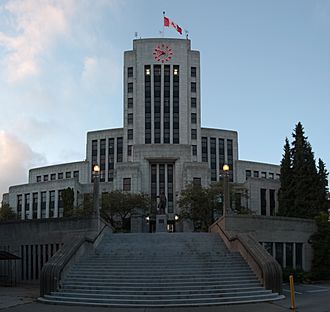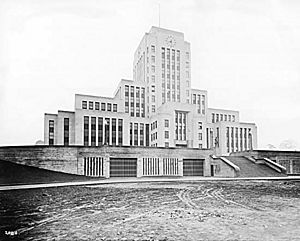Vancouver City Hall facts for kids
Quick facts for kids Vancouver City Hall |
|
|---|---|

Vancouver City Hall
|
|
| General information | |
| Type | City hall |
| Architectural style | Art Deco |
| Address | 453 West 12th Avenue Vancouver, British Columbia V5Y 1V4 |
| Coordinates | 49°15′39″N 123°6′50″W / 49.26083°N 123.11389°W |
| Construction started | 1935 |
| Completed | 1936 |
| Inaugurated | December 2, 1936 |
| Cost | $1 million |
| Owner | City of Vancouver |
| Height | 98 metres (322 ft) |
| Technical details | |
| Floor count | 12 |
| Design and construction | |
| Architecture firm | Townley & Matheson |
| Main contractor | Carter-Halls-Aldinger Company |
Vancouver City Hall is a very important building in Vancouver, British Columbia. It's where the Vancouver City Council meets to make decisions for the city. You can find it at 453 West 12th Avenue. The building was designed by architect Fred Townley and his team, and it was built by a company called Carter, Halls, Aldinger and Company.
This impressive building has a twelve-storey tower that stands 98 metres (323 feet) above sea level. It even has a clock at the very top! If you want to visit, you can easily get there using SkyTrain's Canada Line at the Broadway–City Hall station.
Contents
The History of Vancouver City Hall
Where City Hall Used to Be
Before the current building, Vancouver's City Hall was in a few different places. From 1897 to 1929, it was on Main Street. That building had been a public market and an auditorium before becoming City Hall.
In 1929, City Hall moved into the Holden Building. The old Main Street building then became part of the Carnegie Library.
Choosing a New Location
In 1934, Gerry McGeer became the mayor of Vancouver. He decided it was time for a brand new City Hall. He put together a special group to find the perfect spot. They looked at a few places, including the old Central School site at Victory Square.
They also considered Strathcona Park, which was at the corner of Cambie Street and West 12th Avenue. This is not the same Strathcona Park that exists today. The group decided that the Strathcona Park site was the best choice. In 1935, the City Council agreed. This made Vancouver the first big city in Canada to build its City Hall outside of its main downtown area.
Building the New City Hall
Construction on the new City Hall began on January 3, 1936. This was a special year because it was Vancouver's 50th birthday, also known as its Golden Jubilee. Mayor McGeer himself laid the first cornerstone on July 2.
A large, eight-foot tall statue of Capt. George Vancouver was placed at the front of the building. This statue was created by Charles Marega. On August 20, the Lord Mayor of London, Sir Percy Vincent, came to Vancouver to officially reveal the statue. Sir Percy also gave some special gifts to the city. One gift was a civic mace, which is a ceremonial staff. Another gift was a small branch from a tree in the orchard where Isaac Newton supposedly got the idea for his theory of gravity when an apple fell. Both the mace and the statue are still at City Hall today.
The building was started and finished in the same year! It cost $1 million to build and was completed on December 1, 1936. The whole construction process took only 330 days.
Special Details of the Building
The designers added many unique touches to the new City Hall.
- Each lock plate on the outer doors shows the Vancouver Coat of Arms.
- Every doorknob has the building's special monogram.
- The ceiling on the second floor of the rotunda (a round room) was made with real gold leaf from mines in BC.
The First Mayor in the New Hall
After winning the city election on December 9, 1936, George Clark Miller became the first mayor to work in the brand-new City Hall. He moved in on January 2, 1937.
Changes Over the Years
In 1968, a four-storey east wing was added to the building, and it was finished in 1970. In 1969, a coat of arms was added to the building.
In March 1976, the original City Hall building was officially recognized as a "Schedule A heritage building." This means it's considered very important and needs to be protected.
Around 2012, city staff started moving out of some parts of the building. This happened after a study showed that the building might not be strong enough to handle a major earthquake safely.


